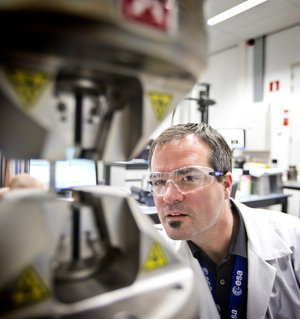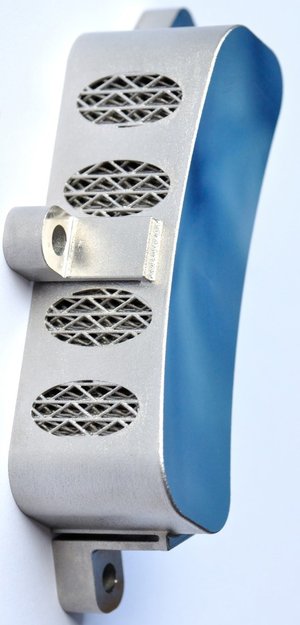Maintaining performance with greener materials: Tommaso Ghidini interview
As head of ESA’s Materials Technology section, Tommaso Ghidini has his focus on advanced materials and the entire manufacturing process producing space missions.
The link to Clean Space is obvious: if mission births can occur in a more environmentally-friendly way, then the rest of their life cycle will be cleaner too. The manufacturing phase of spacecraft and launchers often constitutes a significant portion of their environmental footprint.
How are you involved in Clean Space?
As the Head of the Materials Technology section of ESA’s Directorate of Technical and Quality Management, I’m focused on mainly metallic materials used for space missions, and their related preparation and manufacturing processes. Our section’s mandate is to characterise their performance to optimise their quality and reliability, guaranteeing they are fit for their purpose.
Inevitably, some of the materials, processes and coatings that we work with are relatively ‘dirty’ in environmental terms, or hazardous in terms of health and safety, so we are looking into cleaner alternatives. The challenge is to find greener replacements that maintain the same performance as the nasty ones.

Why does this need to be done?
Partially, it comes down to anticipating trends in the wider aerospace industry. Notably, the European Union’s Registration, Evaluation, Authorisation and Restriction of Chemicals (REACH) regulations mean that numerous commonly-used chemicals could at some point be banned and withdrawn from use without a special waiver. These represent an obvious priority for us.
Take for instance chromate-based coatings, used to reduce corrosion. Their performance makes them God’s gift for corrosion protection – but chromates are also carcinogenic. So we have been testing various cleaner candidates in the hope of finding a complete replacement. Or, in case we don’t find it, we are also considering tailoring operating requirements to minimise chromate use in future: for instance, a launcher exterior exposed to coastal conditions – such as on the launch pad in French Guiana – could have more stringent corrosion protection requirements than something kept in a controlled, protected environment throughout its time on Earth.
Or look at the move towards greener electronics. Right now, for electronics soldering, lead is added to the tin solder. This has to be done because pure tin grows ‘whiskers’ in the space environment, and the resulting short circuits have been known to cause the loss of satellites. Lead is of course hazardous to people, so we are looking for alternatives. Or gallium arsenide, the most commonly used substrate for solar cells, which is also toxic. But any cleaner alternatives needs to allow the same performance – which is where the real challenge comes in.

Then there is the fact that if we do manage to find cleaner materials and processes, it should make our space industry even more competitive, paying back economically as well from a health and environment point of view.
Examples here include additive manufacturing – otherwise known as 3D printing – where you build up material to make your final product, which can mean more than 50% or even as high as 95% less waste, and significantly cut lead times and the number of steps in the process chain. Or solid state or friction stir welding, where the use of lower temperatures for welding means less energy expended, and a consequent reduction in fumes, spatter, ultraviolet light, chemical cleaning needs and health hazards for personnel. It means the mechanical properties of your joint are better, and multiple passes can be replaced by one or two passes. So you will obtain better products through a less resource intensive process – the cleaner alternative ends up cheaper and quicker as well.

How did you get your start in the space business?
It was always an objective of mine and I have been determined at pursuing it. I studied for a degree in mechanical engineering then a PhD and did work at the German Aerospace Center, DLR, before ending on the Airbus A380 project, in the area of fracture mechanics. I then became a fracture mechanics expert at ESA, before serving on the Vega project as quality engineer. That was a wonderful team and I had the award of seeing a wonderful launch. The A380 is a relatively low energy vehicle that flies frequently while the Vega is the opposite; a high-energy vehicle that flies less often. So to work on both has been extremely rewarding. After that very important experience I came back to lead the Materials Technology section.
What has been your biggest surprise about working here?
The sheer enthusiasm bound up in the work being done. The first time the Vega launcher was seen on the Kourou launch pad, I saw people crying – very competent and tough engineers were crying, as they saw the tangible outcome of their years of work: not a computer simulation or drawing or finite element model, but the actual reality. To me that shows the human side of our work, the emotional involvement which is a key factor.

What is your opinion of the overall Clean Space initiative?
On a personal level, it’s our responsibility to protect our planet as much as possible. As for space, I like to quote something that ESA Director General Jean-Jacques Dordain once remarked: “when we found space it was clean, and we need to leave it that way.” And the Materials side is really where things happen, where intervention will give a big result, not only for a cleaner space, but also for a cleaner Earth. Especially with our launchers, the volume of manufacturing is significantly high – change something in the process and that’s a lot of mass, and an enormous environmental impact downstream.















 Germany
Germany
 Austria
Austria
 Belgium
Belgium
 Denmark
Denmark
 Spain
Spain
 Estonia
Estonia
 Finland
Finland
 France
France
 Greece
Greece
 Hungary
Hungary
 Ireland
Ireland
 Italy
Italy
 Luxembourg
Luxembourg
 Norway
Norway
 The Netherlands
The Netherlands
 Poland
Poland
 Portugal
Portugal
 Czechia
Czechia
 Romania
Romania
 United Kingdom
United Kingdom
 Slovenia
Slovenia
 Sweden
Sweden
 Switzerland
Switzerland





























